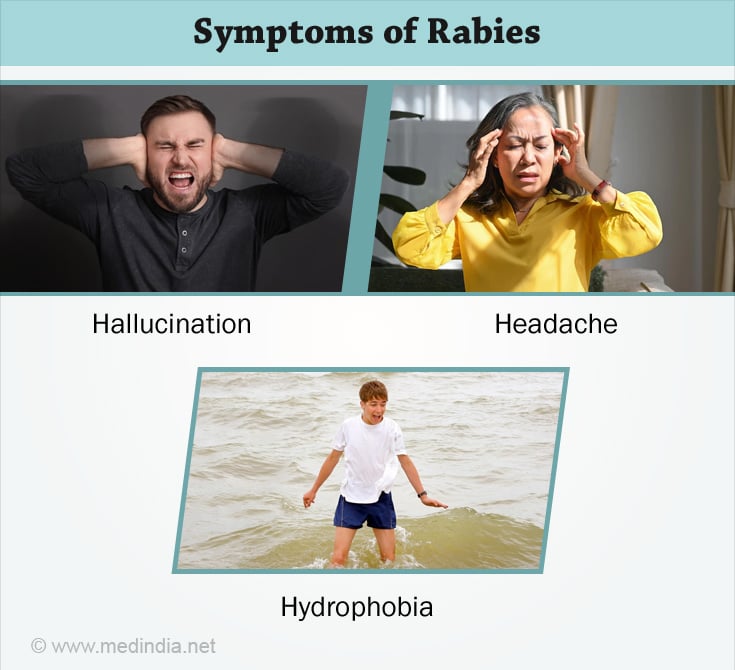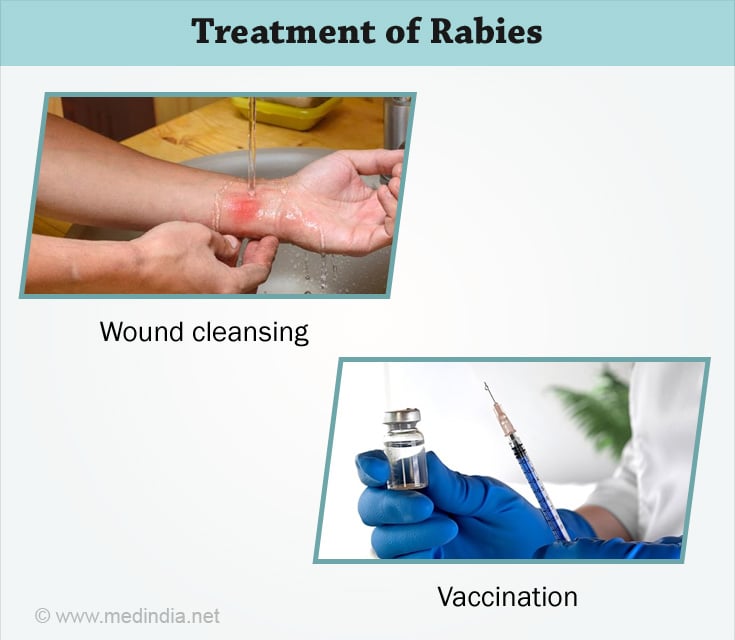- Rabies: Definition - (https://pubmed.ncbi.nlm.nih.gov/29188797/)
- Rabies Day - (https://www.cdc.gov/worldrabiesday/index.html)
- Rabies Virus - (https://pubmed.ncbi.nlm.nih.gov/30072086/)
- Domestic Animals - (https://www.cdc.gov/rabies/exposure/animals/domestic.html)
- World Rabies Day - (https://www.who.int/campaigns/world-rabies-day)
- Imaging findings in rabies encephalitis - (https://www.ncbi.nlm.nih.gov/pmc/articles/PMC7976035/)
- Rabies - (https://www.who.int/health-topics/rabies#tab=tab_1)
- Rabies : Types - (https://www.who.int/news-room/fact-sheets/detail/rabies)
- How is rabies transmitted? - (https://www.cdc.gov/rabies/transmission/index.html)
- Animals and Rabies - (https://www.cdc.gov/rabies/animals/index.html)
- A case of human rabies with a long incubation period in Wuhan - (https://www.ncbi.nlm.nih.gov/pmc/articles/PMC7724148/)
- Rabies : Symptoms - (https://www.cdc.gov/rabies/symptoms/index.html)
- Antemortem diagnosis and prevention of human rabies - (https://www.ncbi.nlm.nih.gov/pmc/articles/PMC2781142/)
- Survival in human rabies but left against medical advice and death followed - Community education is the need of the hour - (https://www.ncbi.nlm.nih.gov/pmc/articles/PMC7266186/)
- Studies on the local treatment of wounds for the prevention of rabies - (https://pubmed.ncbi.nlm.nih.gov/14453773/)
- New Rabies Vaccines for Use in Humans - (https://www.ncbi.nlm.nih.gov/pmc/articles/PMC6631309/)
- Rabies antibody levels in pregnant women and their newborns after rabies post-exposure prophylaxis - (https://www.ncbi.nlm.nih.gov/pmc/articles/PMC4163280/)
- Intravenous human rabies immunoglobulin for post-exposure prophylaxis: serum rabies neutralizing antibody concentrations and side-effects - (https://pubmed.ncbi.nlm.nih.gov/2646301/)
- Rabies Prevention - (https://www.cdc.gov/rabies/prevention/index.html)
About
Rabies is a zoonotic viral disease which affects domestic and wild animals. Rabies is an infectious disease that can be transmitted from animals to humans(1✔ ✔Trusted Source
Rabies: Definition
Go to source).
Each year, rabies kills more than 60,000 people and millions of animals around the world(2✔ ✔Trusted Source
Rabies Day
Go to source).
Rabies transmission occurs through close contact with the saliva from infected animals through bites, scratches, or licks on broken skin and mucous membranes(3✔ ✔Trusted Source
Rabies Virus
Go to source).
Following a bite from a suspected rabid animal, it is essential to clean the wound properly. In addition, immunization should start immediately along with the administration of human rabies immunoglobulin. The newer vaccines have a shorter schedule and are less commonly associated with side effects, as compared to the older vaccines.
The above measures, if started immediately, can prevent the onset of rabies and death. Once the infection is established, death is inevitable. In such circumstances, the person should be isolated and provided nursing care in the last days.
The animal should be observed for a period of at least 10 days following a bite. If the animal is alive and well till this time, it is unlikely that it suffers from rabies. If the animal dies, examination on a sample of the brain helps in the diagnosis(4✔ ✔Trusted Source
Domestic Animals
Go to source).
World Rabies Day is observed on September 28. The date also marks the anniversary of Louis Pasteur's death, the French chemist and microbiologist, who developed the first rabies vaccine(5✔ ✔Trusted Source
World Rabies Day
Go to source).
Rabies encephalitis is one of the oldest communicable diseases known to man. It is an acute infection involving the central nervous system (CNS) in humans and other mammals caused by an RNA virus of the rhabdovirus family. Transmission of the disease is through the bite of dogs and wild animals(6✔ ✔Trusted Source
Imaging findings in rabies encephalitis
Go to source).
Types of Rabies
There are two forms of rabies(7✔ ✔Trusted Source
Rabies
Go to source):
- Furious rabies – characterized by hyperactivity and hallucinations.
- Paralytic rabies – characterized by paralysis and coma.
Furious rabies results in hyperactivity, excitable behavior, hallucinations, lack of coordination, hydrophobia (fear of water), and aerophobia (fear of drafts or of fresh air). Death occurs after a few days due to cardio-respiratory arrest.
Paralytic rabies accounts for about 20% of the total number of human cases. This form of rabies runs a less dramatic and usually longer course than the furious form. Muscles gradually become paralyzed, starting from the wound site. A coma slowly develops and eventually death occurs. The paralytic form of rabies is often misdiagnosed, contributing to the under-reporting of the disease(8✔ ✔Trusted Source
Rabies : Types
Go to source).
What are the Causes of Rabies?
Rabies is caused by a virus
It is usually transmitted to humans through the bite or scratch from an infected animal (rabid dogs) and less frequently by cats. It can also be transmitted if the infected saliva enters the body through broken skin. Rabies may be contracted by inhalation of virus-containing aerosol or via transplantation of an infected organ, but this is very rare.
From the wound site the virus enters the muscles and travels to the brain via the peripheral nerves. It multiplies in the brain and causes swelling or inflammation(9✔ ✔Trusted Source
How is rabies transmitted?
Go to source).
Other animals that can spread rabies include(10✔ ✔Trusted Source
Animals and Rabies
Go to source):
- Foxes
- Bats
- Raccoons
- Skunks
What are the Symptoms and Signs of Rabies?
The initial symptoms of rabies are non-specific but may progress to mild fever, anxiety, agitation, hydrophobia, aerophobia, etc.
Usually the incubation period of rabies is 1–3 months, but may vary from less than 1 week to more than 1 year(11✔ ✔Trusted Source
A case of human rabies with a long incubation period in Wuhan
Go to source).

The initial symptoms of rabies are usually non-specific and suggest involvement of the respiratory, gastrointestinal and/or central nervous systems. Symptoms include(12✔ ✔Trusted Source
Rabies : Symptoms
Go to source) -
- Fever
- Headache
- Pain and tingling at the site of the bite
Ten days later, the patient may experience -
- Anxiety, agitation or depression
- Hallucinations
- Bizarre behavior
- Drooling
- Convulsions
- Increased excitability, which is the hallmark of the condition
- Hydrophobia (fear of water) is present in half the patients. This is usually due to difficultywith swallowing.
- Aerophobia (fear of fresh air) is considered a characteristic feature of rabies
- The patient goes on to develop fits and respiratory paralysis.
Death usually occurs within 10-14 days. Without intensive care, death occurs during the first seven days of illness.
How can we Diagnose Rabies?
Diagnosis is made by rabies specific signs as there are no specific tests to detect the rabies virus before the actual onset of the clinical disease.
Diagnosis of rabies is generally made based on the presence of rabies-specific signs like hydrophobia and aerophobia. No specific tests are available to detect the rabies virus before the actual onset of the clinical disease.
The suspected rabid animal should be observed for a duration of up to 10 days following a bite. If the animal is alive till this time, then it is unlikely that it suffers from rabies.
The direct fluorescent antibody test (DFA) is most frequently used to diagnose rabies in animals. This test can be performed on brain tissue of dead animals suspected of being rabid. Specific collections of particles called Negri bodies are seen on microscopic examination of brain tissue.
This same test can be used to check for rabies infection in humans by using a piece of skin from the neck.
Isolation of the virus from saliva or spinal fluid of the patient can also be done. Specific antibodies produced by the body against the virus can be highlighted in the salivary secretions. However, these tests are not as sensitive and the diagnosis should be confirmed on a suspected animal by examining its brain a under microscope for changes related to rabies(13✔ ✔Trusted Source
Antemortem diagnosis and prevention of human rabies
Go to source).
How can Rabies be Treated?
Proper wound cleansing, immunization and administration of human rabies immunoglobulin can prevent the onset of rabies and death. Rabies has approximately 100% mortality rate but by using the aggressive treatment approach, the patient may survive(14✔ ✔Trusted Source
Survival in human rabies but left against medical advice and death followed - Community education is the need of the hour
Go to source).
Rabies kills if it is not prevented or treated immediately. Effective treatment soon after exposure to rabies virus can prevent the onset of symptoms and death.
Treatment of rabies following infection comprises of -
- Local treatment of the wound
- Immediate vaccination
- Administration of human rabies immunoglobulin (HRiG)
Local treatment of the wound - The wound should be washed thoroughly for a minimum of 15 minutes with soap and water, povidone iodine or other substances that kill the rabies virus(15✔ ✔Trusted Source
Studies on the local treatment of wounds for the prevention of rabies
Go to source).
Vaccination - An anti-rabies vaccine is generally given in 5 doses over 28 days.The standard rabies vaccine schedule is five doses on days 0, 3, 7, 14 and 28, with day '0' being the day of commencement of vaccination. One shot is given around the area of the bite. The rest are given in the arm(16✔ ✔Trusted Source
New Rabies Vaccines for Use in Humans
Go to source). Sometimes, an additional shot is required on the first day if it is not possible to give all the vaccine around the site of the bite. The rabies vaccine produces an immune response, which helps the body fight off the virus. The shot makes the body produce antibodies that kill the virus. Rabies vaccine is safe for use among pregnant and breastfeeding women(17✔ ✔Trusted Source
Rabies antibody levels in pregnant women and their newborns after rabies post-exposure prophylaxis
Go to source).

The vaccine is available free of cost in government hospitals and facilities. In private hospitals and clinics, the cost of Anti Rabies vaccine is Rs.350/-per dose., so the cost of 5 doses will approximately be around Rs.1,700- 2,000.
Administration of human rabies immunoglobulin (HRiG) - HRiG is given on the day of the bite. Half of the HRiG should be injected around the wound and the other half should be given intramuscularly(18✔ ✔Trusted Source
Intravenous human rabies immunoglobulin for post-exposure prophylaxis: serum rabies neutralizing antibody concentrations and side-effects
Go to source).
Once the disease is established, therapy is to relieve the symptoms as death is inevitable.
- The patient should be isolated and nursed in a dark, quiet
- Nutrition, respiration, and heart condition should be monitored and supported.
- Drugs to sedate the patient, relieve pain and to reduce hallucinations can be given liberally.
Prevention of Rabies
Rabies can be prevented with the following measures(19✔ ✔Trusted Source
Rabies Prevention
Go to source):
- Vaccinate your dogs, cats, and ferrets against rabies.
- Keep your pets under supervision.
- Do not handle wild animals.
- If you see a wild or a stray animal, especially if the animal is behaving strangely, call an animal control officer.
- If you do get bitten by an animal, wash the wound with soap and water for at least 5 minutes.
- Make sure you tell an adult and call your doctor to see if you need shots.
- For individuals at risk like laboratory workers, animal handlers and veterinarians, two doses of anti-rabies vaccine should be given four weeks apart. A reinforcing dose after 12 months and every 1-3 years may be given if necessary.












